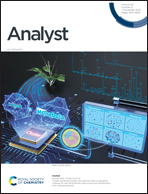An ECL sensor combined with a paper electrode for the determination of phenylalanine†
Abstract
Herein, a unique electrochemiluminescence (ECL) sensor combined with a paper electrode was proposed for the detection of phenylalanine (L-Phe) in blood samples. The L-Phe detection was performed by converting L-Phe into ammonia using phenylalanine ammonia-lyase (PAL) enzyme and the ECL signal of Ru(bpy)32+ was produced in combination with ammonia as a co-reactant. In this report, we used AuNP decorated paper electrodes to obtain the ECL signal of Ru-(bpy)32+ in the presence of NH3. The produced ammonia molecules were carried to the working electrode and their contact with the sample was cut off. Since there was no contact between the sample matrix and the electrode, the developed method achieved excellent selectivity. According to experimental data, a linear increase of the ECL signals with the logarithms of varying L-Phe concentrations between 1.5 × 10−2 and 1.211 mM was observed with a correlation coefficient (R2) of 0.9898 and a limit of detection (LOD) of 8.4 × 10−3 mM. The proposed method was efficiently applied for L-Phe detection in reference blood samples and the average recovery was calculated as 96.8%. Furthermore, the HPLC-UV method as a comparison verified that the recovery values provided by the proposed method were acceptable with a similarity of 95.1% for L-Phe detection in a reference blood sample. The results showed that the developed ECL sensor combined with the paper electrode can be considered as a promising unique and powerful technique for a point-of-care diagnosis of PKU.



 Please wait while we load your content...
Please wait while we load your content...